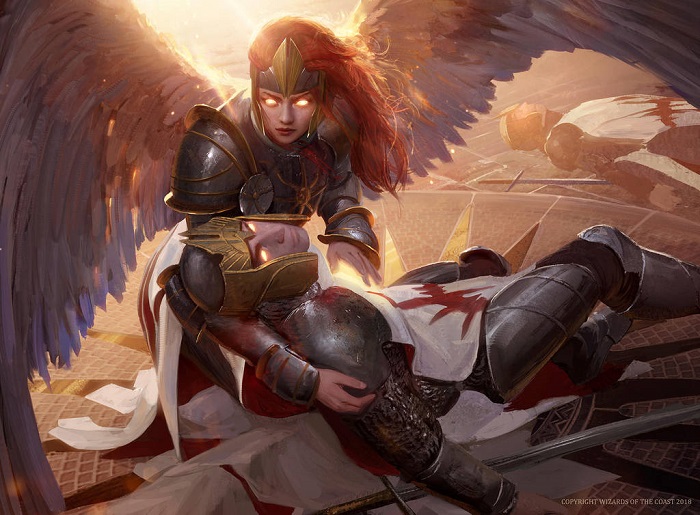Time After Time
“The world, I’ve come to realize, is a blank canvas on which to paint.” —Ixidor, reality sculptor
Commander is the best Magic: The Gathering format for expression. With just about every card available to a deck builder, Commander is truly a blank canvas, and any idea is at least worth trying out. Outside of the most cutthroat of tables, even the most far out strategies can find some wins.
This is Mind Bend, an article series dedicated to translating established strategies into the “wrong” colors. I hope to inspire you to look at the format in a different way, under a different light, and perhaps find something you might not have considered before.
A New Chance
This first article is inspired by the new Guilds of Ravnica card Chance for GloryChance for Glory. While others might be talking about new commanders like Lazav, the MultifariousLazav, the Multifarious or the instant auto-include Assassin’s TrophyAssassin’s Trophy, the card Chance for GloryChance for Glory jumped out at me because of something I tried to make work in the past.

A year or so ago, I put together a mono-red deck that relied on looping the three extra turn spells available: Final FortuneFinal Fortune, Last ChanceLast Chance, and Warrior’s OathWarrior’s Oath. It wasn’t a great success, maybe because it also centered around Vent SentinelVent Sentinel and red walls, but probably because the deck never had a way to consistently complete its ultimate strategy of taking many turns in a row.

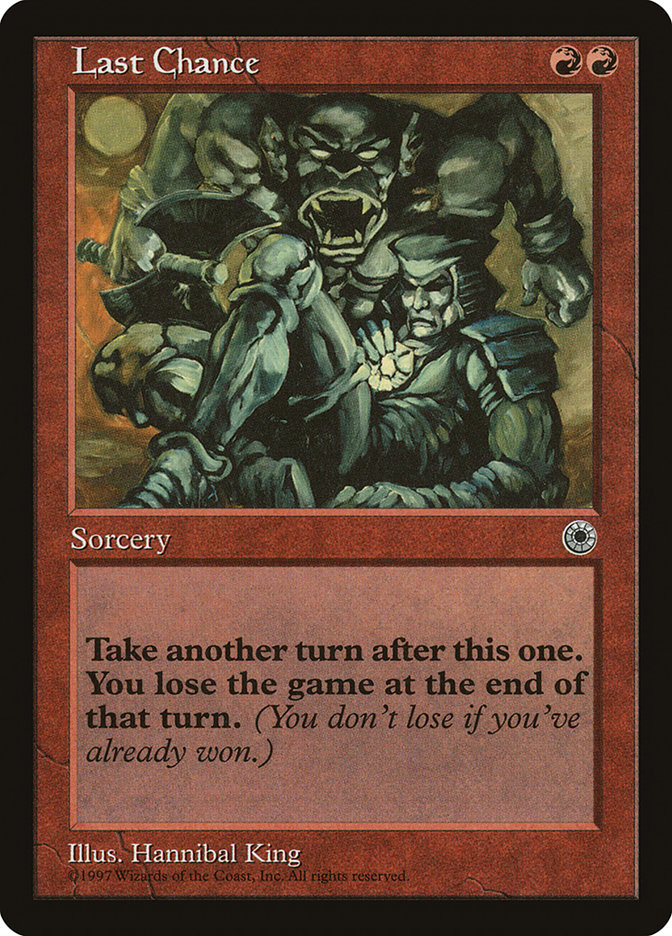
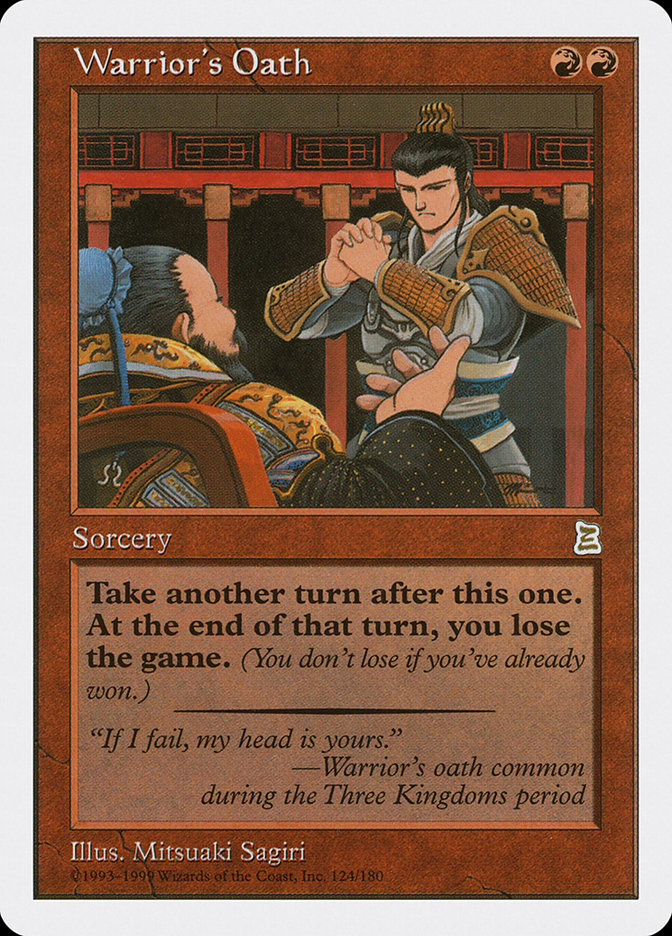
Like the new card name implies, I find that now is my Chance for GloryChance for Glory. The new instant provides a fourth extra turn option, so the deck will be that much closer to consistency, though it does require a switch to at least Boros from mono-red.
Great. From one “bad” color to the “worst” two-color combination in the format. Time to look for more inspiration, or at least a road map for how to put this thing together.
Going Blue
Taking extra turns lies almost exclusively within the color blue, from game winners like ExpropriateExpropriate and Time StretchTime Stretch to more reasonable, but still powerful effects, like Time WarpTime Warp and Temporal MasteryTemporal Mastery. This goes all the way back to Alpha, where you find the very-banned-in-Commander Power Nine card Time WalkTime Walk.
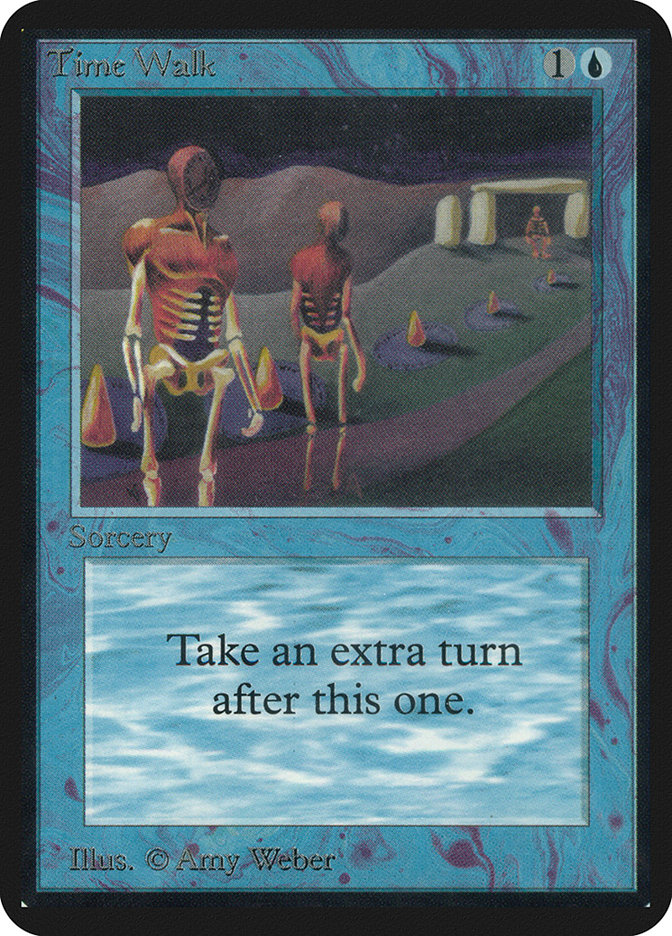
Nowadays, blue doesn’t get extra turns for two mana like Time WalkTime Walk. The mana cost is usually 5 or more, and in the most recent iterations, those spells exile themselves on resolution, or are shuffled back into the deck. See cards like Karn’s Temporal SunderingKarn’s Temporal Sundering or Nexus of FateNexus of Fate for more information on Wizards of the Coast’s recent extra turn spell design philosophy.
But in the older days of Magic, cards like that would stay in the graveyard, where they’re ripe for abuse. Let’s look at EDHREC’s top played cards alongside one of the most basic of extra turn spells - Time WarpTime Warp.

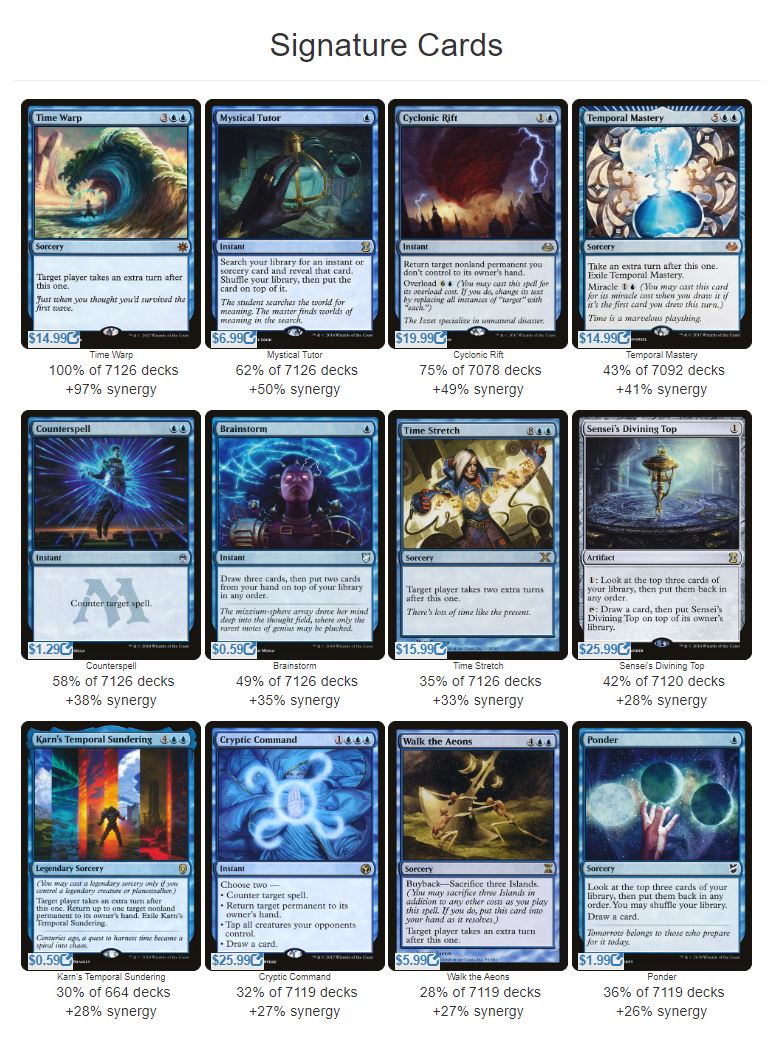
Not much uniqueness here, huh? A handful of the best blue cards alongside a few extra turn spells. The top cards section isn’t much of change from this model, either.
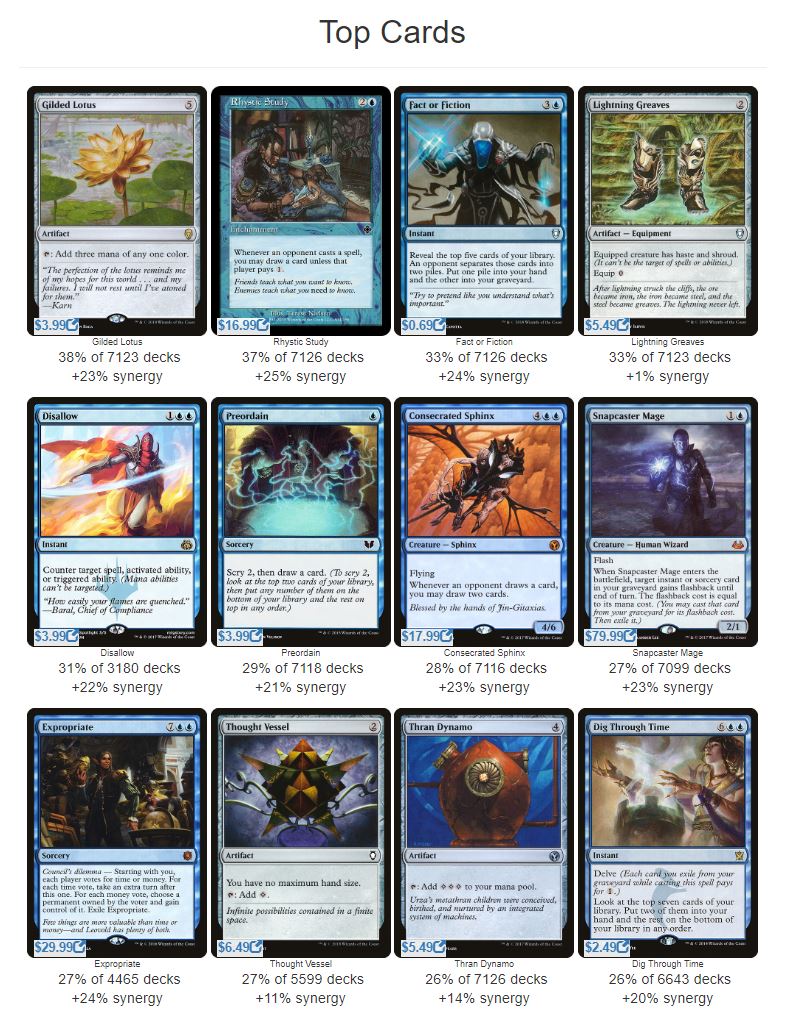
Yep, more of the same. The only card to note here is Snapcaster MageSnapcaster Mage, since when coupled with Time WarpTime Warp, you can cast it at least one more time out of the graveyard.
Looking at the top creatures not in the two above categories, a different story starts to unfold:
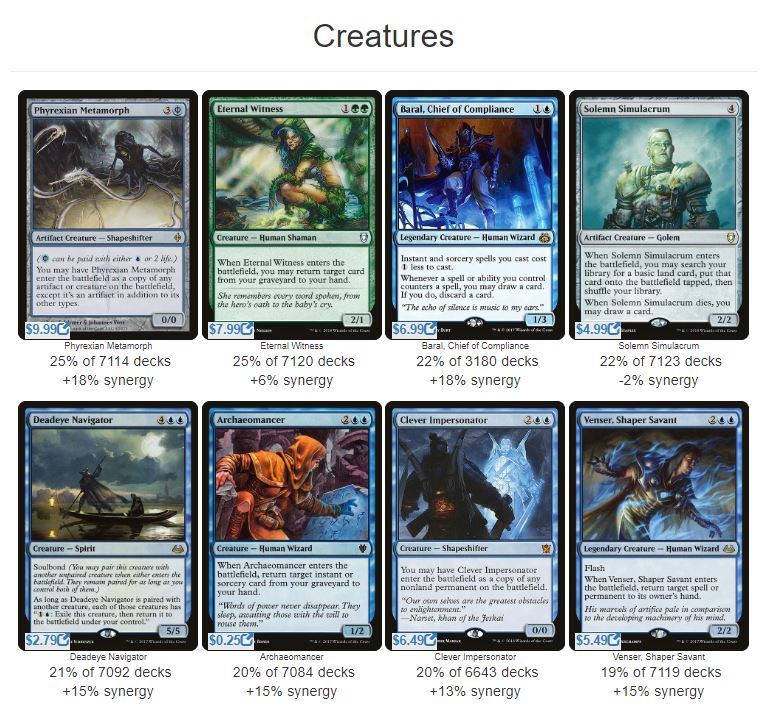
Now here’s something more focused! Two cards to pay attention to here are Eternal WitnessEternal Witness and ArchaeomancerArchaeomancer. They allow you to get back cards like Time WarpTime Warp to keep the extra turn train running. Add in another card on this list, Deadeye NavigatorDeadeye Navigator, and you can loop as many turns as you want for 7 total mana.
That’s more like it. I don’t want to just cast one extra turn spell, I want to cast them over and over again!
Another one of blue’s strengths is obviously the ability to draw many, many cards, which makes the extra turn strategy come together rapidly, considering that you will see much more of your deck than other players might.
What’s interesting, though, is that outside of a few cards that can fish instants and sorceries out of the graveyard, blue struggles with casting these cards again and again. Blue is the absolute best at copying creatures or artifacts, but despite being heavily instant and sorcery focused, can’t copy those with a great efficiency.
But you know what color can?
Yep, red.
Seeing Red (and Green and White)
Taking cues from what we learned about on the EDHREC page for Time WarpTime Warp, let’s apply them to a non-blue deck:
- Select the best extra turn spells you can find.
- Find a way to either loop or copy said extra turn spells for maximum fun.
- Sprinkle in efficient card draw and the best all-around spells you can muster.
Well, part one is on lockdown, with Chance for GloryChance for Glory, Final FortuneFinal Fortune, Last ChanceLast Chance, and Warrior’s OathWarrior’s Oath as the go to spells. The great thing about each of these cards is their very low mana cost and the fact that they don’t exile or shuffles themselves on resolution That means they’re prime for the picking with any number of cards that can RegrowthRegrowth spells to our hand.
Oops All Loops

RegrowthRegrowth? Hmm. Earlier in this article, one of the top played creatures in decks containing Time WarpTime Warp was Eternal WitnessEternal Witness. Why not play to that strength? Green is the best color for returning anything back to your hand. Or at least it was originally. Recently, Wizards of the Coast has tweaked that ability slightly in green so that the color can only return permanent cards back to hand. For an example, see the recent reprinting of Nature’s SpiralNature’s Spiral in Dominaria for where the design team has been pointing in recent years.
But this is Commander, remember, you can play whatever you want. So this Boros deck is shifting to Naya to welcome RegrowthRegrowth, RecollectRecollect, Eternal WitnessEternal Witness, SkullwinderSkullwinder, and Wildest DreamsWildest Dreams into the fold. Having many, many ways to recur the only four extra turn spells available means that the deck has more “effective” copies of those cards, as a card like RegrowthRegrowth is just a Final FortuneFinal Fortune for two more mana with the latter in the graveyard.
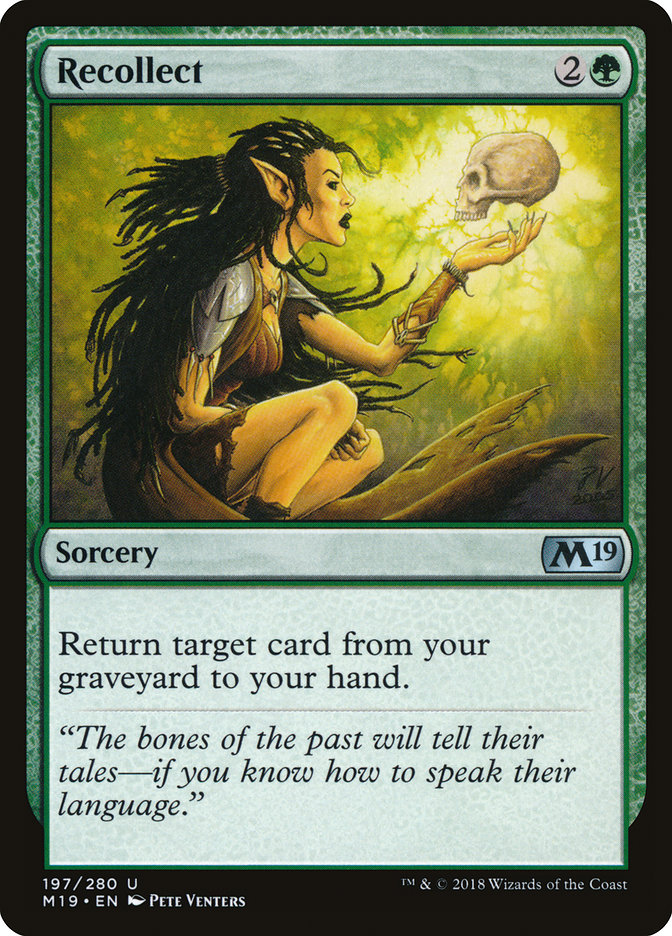
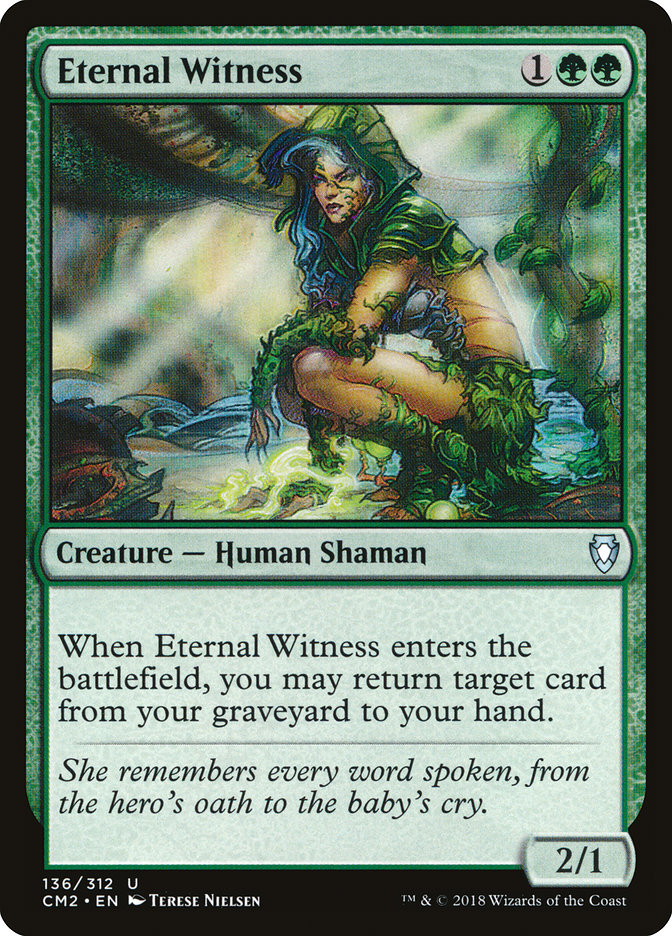

Red itself is no slouch in being able to loop spells out of the graveyard. It offers the fantastic Charmbreaker DevilsCharmbreaker Devils, which if the deck’s pilot is over so lucky to have only an extra turn spell in the graveyard, the turns won’t stop coming. To add to that, red also provides Goblin Dark-DwellersGoblin Dark-Dwellers and Past in FlamesPast in Flames, which don’t return cards back to hand but act as RegrowthRegrowth effects in their own ways. One tip when trying out this strategy: flashback the return to hand cards, and get back the extra turn spells, as you never know when you’ll want them back in the graveyard.
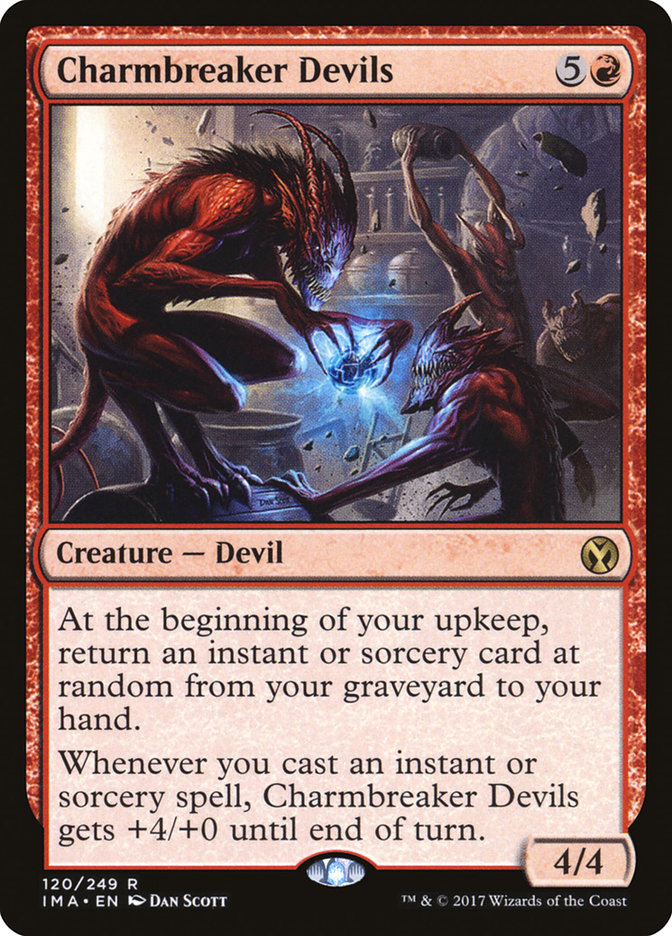
And as a bonus, the deck can also run the fantastic Naya CharmNaya Charm as another RegrowthRegrowth, but at instant speed with other great options tacked on if need be.
Doubles and Draws
So far, the deck can make extra turns and pull those spells out of the graveyard at will. How about playing to another of red’s strengths - copying spells? One turn is good, but three turns is better when utilizing cards like Howl of the HordeHowl of the Horde and Increasing VengeanceIncreasing Vengeance. This deck will feature a good portion of cards with similar copying effects to also maximize the four extra turn spells available. Copy spells also have the added bonus of copying any ramp spells like FarseekFarseek or any card draw spells.
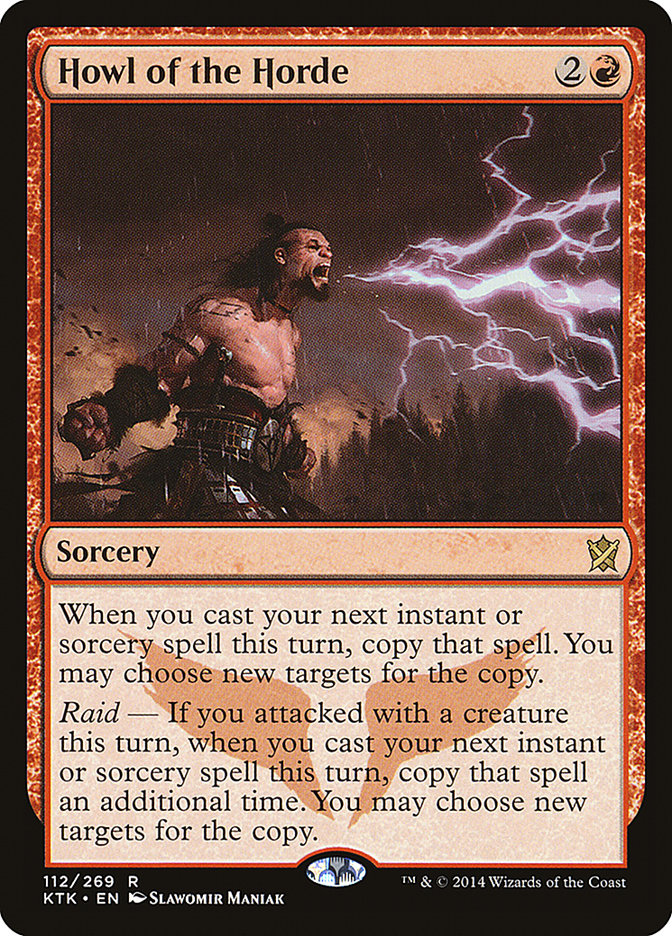

Card draw, what to do here? The deck is firmly in Naya, so the best two colors for drawing cards are out the window. Still, with all the copy effects in the deck’s game plan, spells like Cathartic ReunionCathartic Reunion and Tormenting VoiceTormenting Voice get better as the cost of discarding cards is limited to the original spell and not the copy. Plus, with all the RegrowthRegrowth effects, discarding cards isn’t that big of a deal.

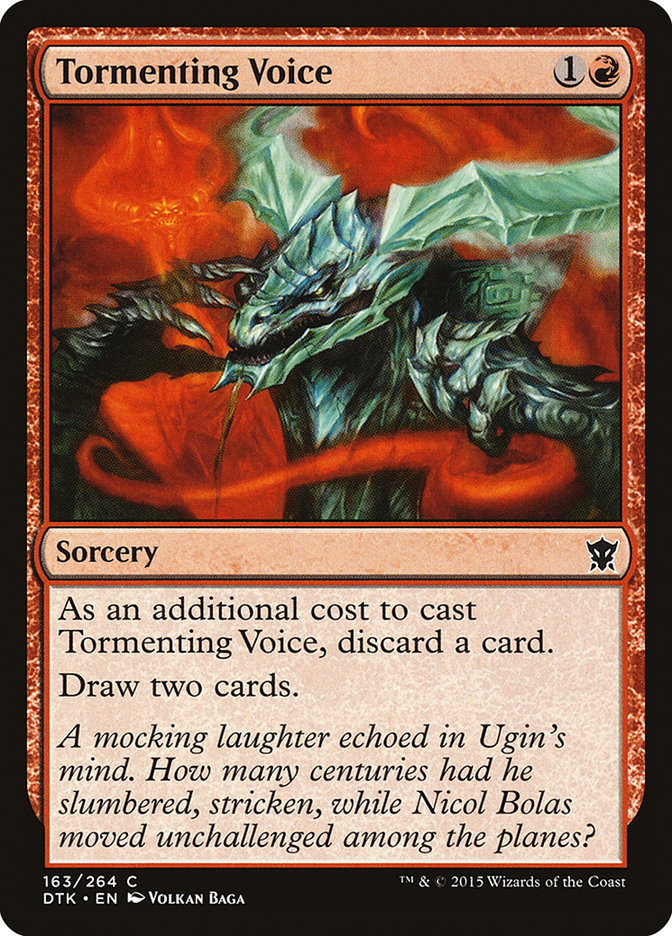
The Opposite of Losing
I feel like I’m still missing something... Oh yeah! All the extra turn spells say, “At the beginning of that turn’s end step, you lose the game.”

No worries, though. Being in Naya means that Sundial of the InfiniteSundial of the Infinite, Platinum AngelPlatinum Angel, Angel’s GraceAngel’s Grace and Gideon of the TrialsGideon of the Trials are all available and going straight into the deck. Add in a Call the GatewatchCall the Gatewatch and an Enlightened TutorEnlightened Tutor and losing the game should not be as much of a concern. Plus, losing to your own Warrior’s OathWarrior’s Oath is not the worst way to bow out of a pod.
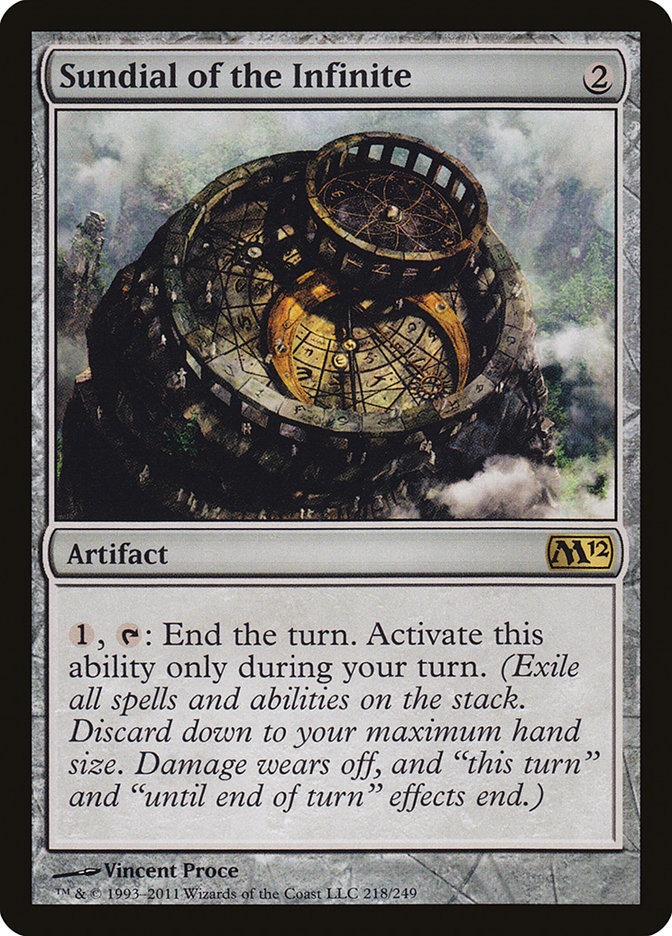
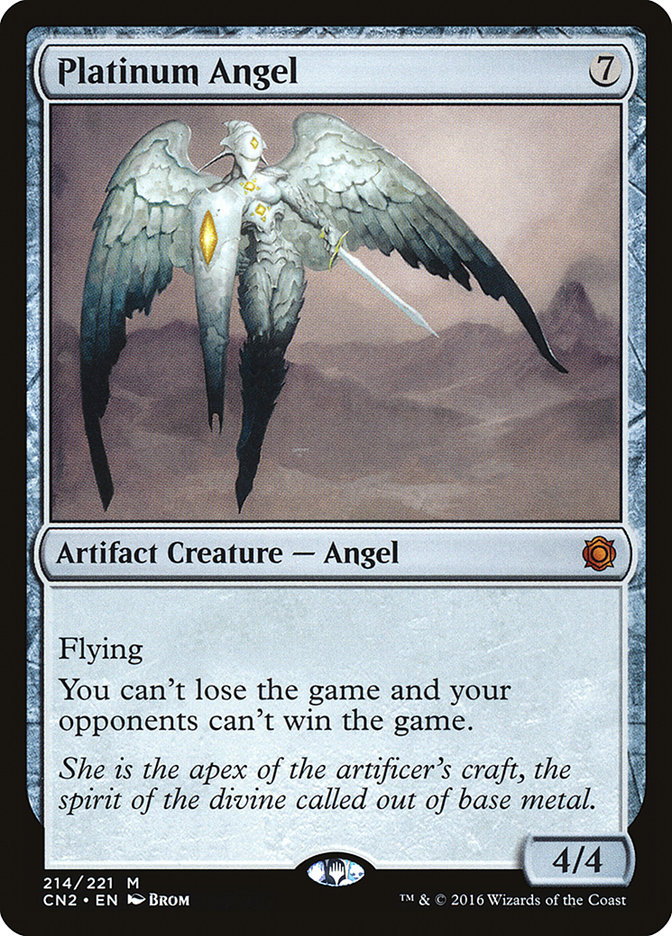

Winning the game can be tricky if all that’s happening here is looping turns. You might as well be playing with yourself. To speed that along, the traditional package of spellslinger go-tos like Young PyromancerYoung Pyromancer, GuttersnipeGuttersnipe, and Monastery MentorMonastery Mentor will fit this strategy just fine.
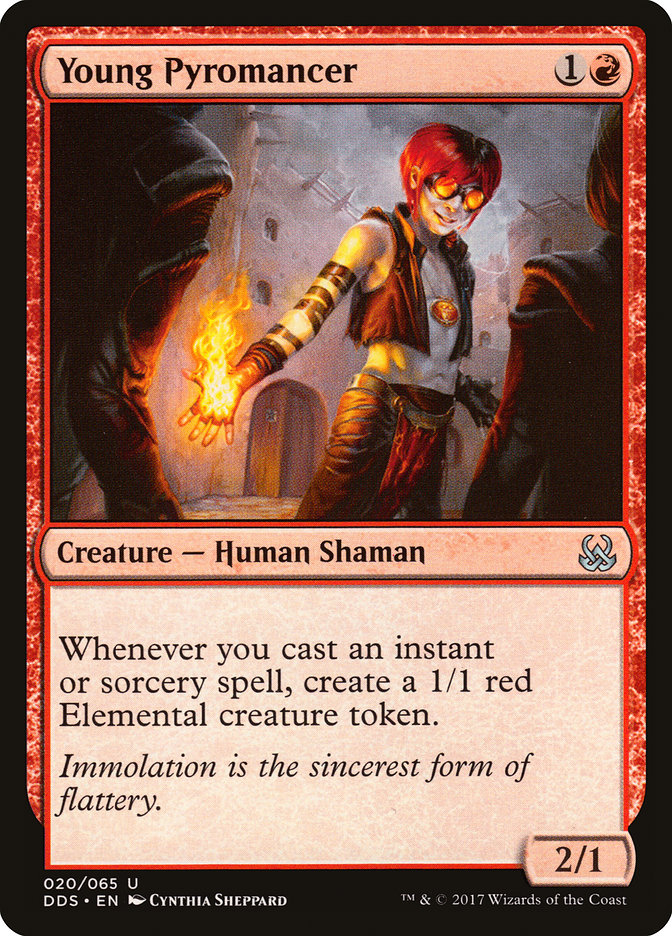
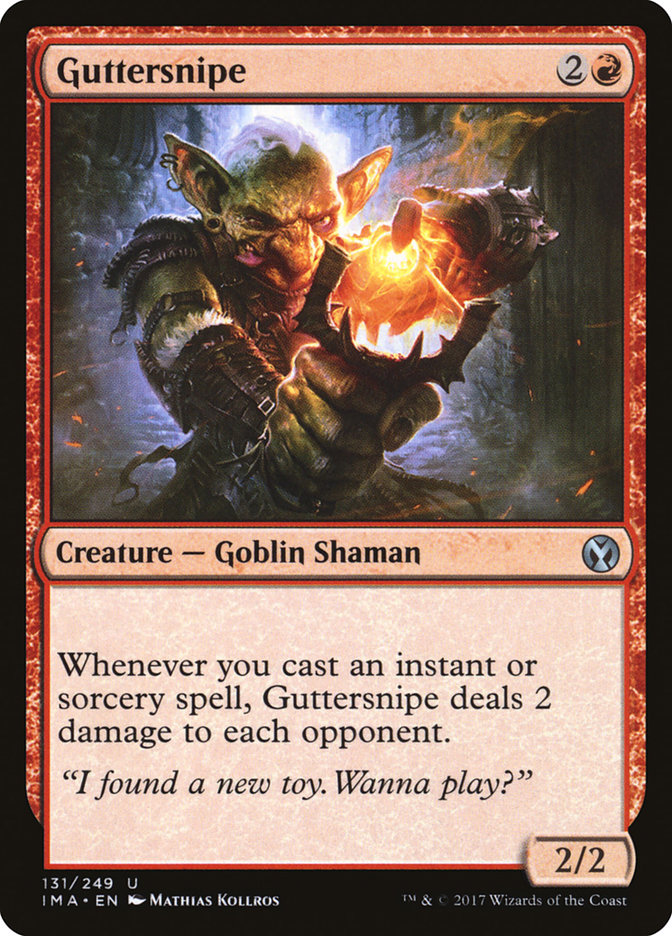
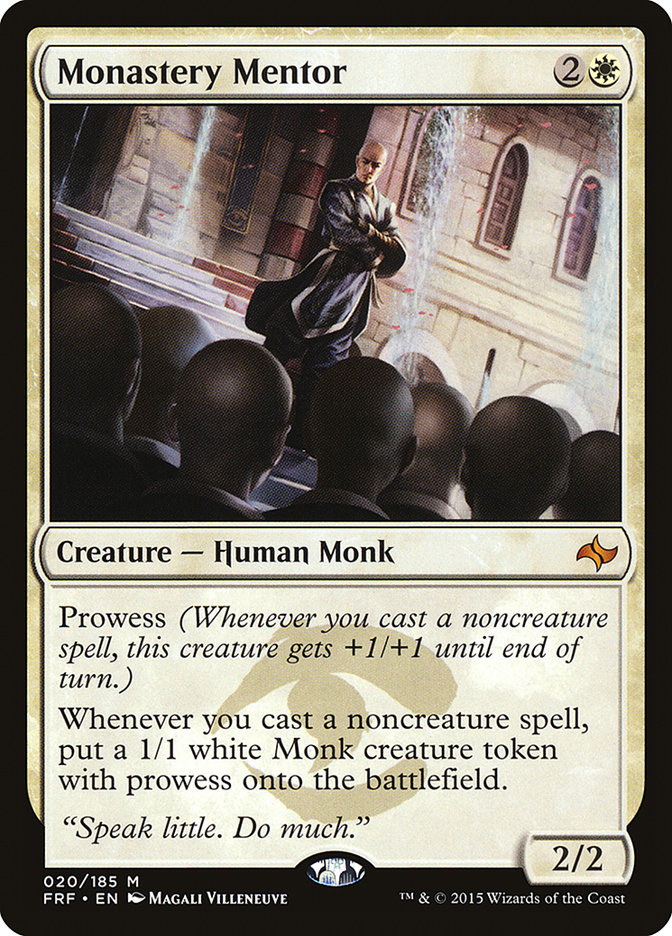
A Special Scepter
Outside of the previously mentioned near-infinite turns trick with Charmbreaker DevilsCharmbreaker Devils, the deck can also employ the occasionally seen in Legacy combo of Final FortuneFinal Fortune + Isochron ScepterIsochron Scepter. Isochron ScepterIsochron Scepter can do a few different things for this strategy. It can also be paired with Noxious RevivalNoxious Revival to mimic the Charmbreaker DevilsCharmbreaker Devils trick, or it can be paired with Angel’s GraceAngel’s Grace to act as another Sundial of the InfiniteSundial of the Infinite (or just be a repeatable FogFog). On top of that, slapping a ReverberateReverberate on it means a build your own MirariMirari.
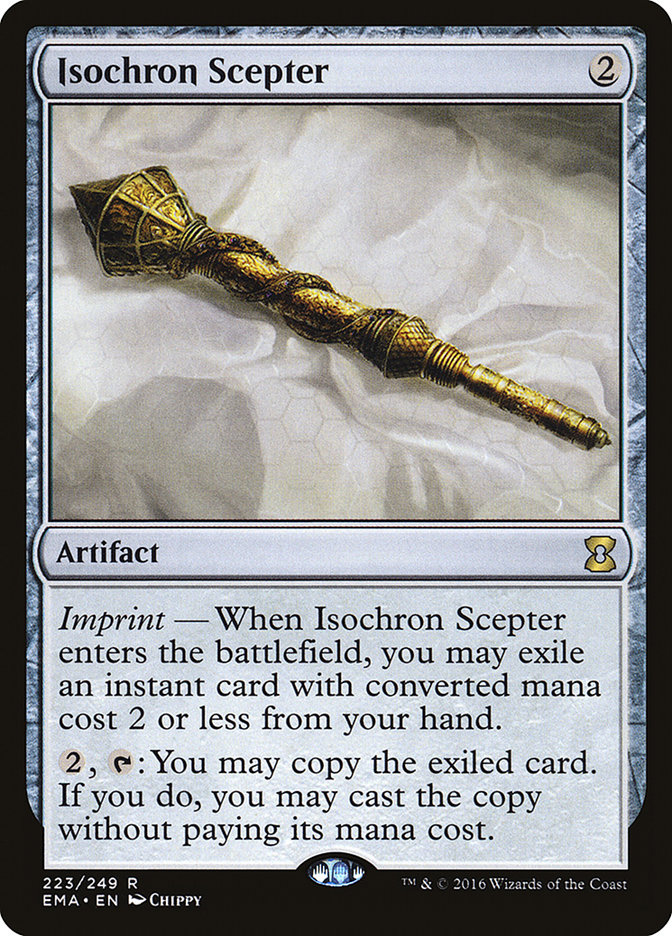
The Final List
In the commander slot, the duo of Bruse Tarl, Boorish HerderBruse Tarl, Boorish Herder and Tana, the BloodsowerTana, the Bloodsower might be the best fit at the time. To be honest, no Naya commander fits perfectly into this strategy, but at least with these partners, the deck can make tokens upon tokens during those extra turns, or simply make Bruse a double striking 3/3 with lifelink and knock some players out of the game.
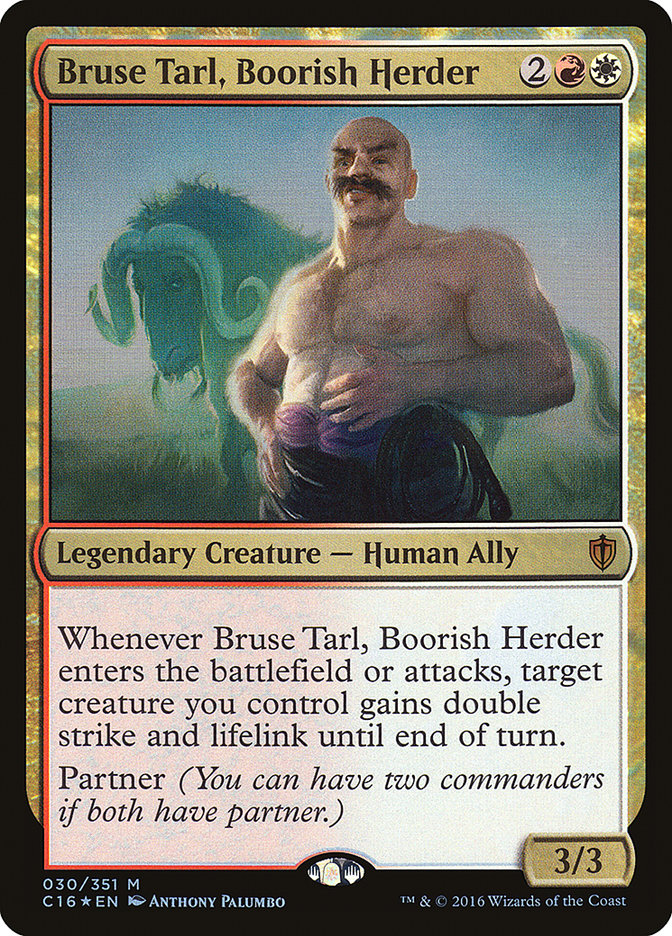
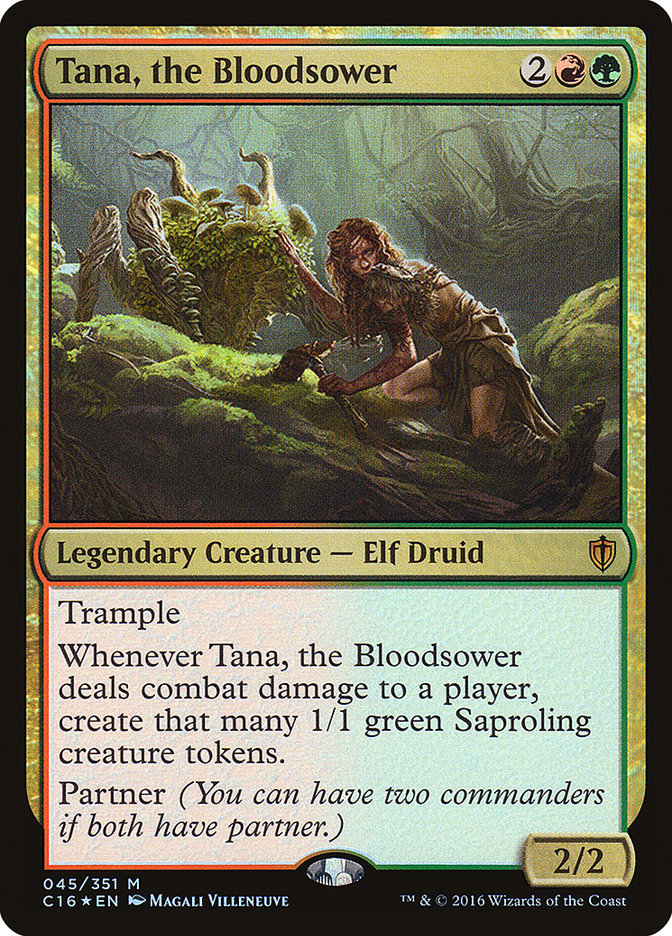
Naya Extra Turns
View on ArchidektCommander (2)
- 1 Bruse Tarl, Boorish HerderBruse Tarl, Boorish Herder
- 1 Tana, the BloodsowerTana, the Bloodsower
Extra Turns (9)
- 1 Final FortuneFinal Fortune
- 1 Last ChanceLast Chance
- 1 Warrior's OathWarrior's Oath
- 1 Chance for GloryChance for Glory
- 1 [Don’t Lose][Don’t Lose]
- 1 Angel's GraceAngel's Grace
- 1 Sundial of the InfiniteSundial of the Infinite
- 1 Gideon of the TrialsGideon of the Trials
- 1 Platinum AngelPlatinum Angel
Cast It Again (22)
- 1 Noxious RevivalNoxious Revival
- 1 Wildest DreamsWildest Dreams
- 1 RegrowthRegrowth
- 1 Shreds of SanityShreds of Sanity
- 1 RecollectRecollect
- 1 SkullwinderSkullwinder
- 1 Eternal WitnessEternal Witness
- 1 Naya CharmNaya Charm
- 1 Past in FlamesPast in Flames
- 1 Goblin Dark-DwellersGoblin Dark-Dwellers
- 1 Charmbreaker DevilsCharmbreaker Devils
- 1 [Makin’ Copies][Makin’ Copies]
- 1 Isochron ScepterIsochron Scepter
- 1 ReverberateReverberate
- 1 Increasing VengeanceIncreasing Vengeance
- 1 Bonus RoundBonus Round
- 1 Howl of the HordeHowl of the Horde
- 1 Fury StormFury Storm
- 1 Wild RicochetWild Ricochet
- 1 Chandra, the FirebrandChandra, the Firebrand
- 1 Pyromancer's GogglesPyromancer's Goggles
- 1 Wort, the RaidmotherWort, the Raidmother
Win the Game (7)
- 1 Firebrand ArcherFirebrand Archer
- 1 Thermo-AlchemistThermo-Alchemist
- 1 Young PyromancerYoung Pyromancer
- 1 GuttersnipeGuttersnipe
- 1 Monastery MentorMonastery Mentor
- 1 Sentinel TowerSentinel Tower
- 1 Sphinx-Bone WandSphinx-Bone Wand
Ramp (9)
- 1 Sol RingSol Ring
- 1 FarseekFarseek
- 1 Nature's LoreNature's Lore
- 1 Rampant GrowthRampant Growth
- 1 Sakura-Tribe ElderSakura-Tribe Elder
- 1 Kodama's ReachKodama's Reach
- 1 CultivateCultivate
- 1 Treasonous OgreTreasonous Ogre
- 1 Jaya BallardJaya Ballard
Draw and Tutor (9)
- 1 Enlightened TutorEnlightened Tutor
- 1 Magmatic InsightMagmatic Insight
- 1 Cathartic ReunionCathartic Reunion
- 1 Sylvan LibrarySylvan Library
- 1 Tormenting VoiceTormenting Voice
- 1 Wild GuessWild Guess
- 1 Call the GatewatchCall the Gatewatch
- 1 Chandra, Torch of DefianceChandra, Torch of Defiance
- 1 Pirate's PillagePirate's Pillage
Answers (8)
- 1 Swords to PlowsharesSwords to Plowshares
- 1 Boros CharmBoros Charm
- 1 Heroic InterventionHeroic Intervention
- 1 Beast WithinBeast Within
- 1 Crush ContrabandCrush Contraband
- 1 Cleansing NovaCleansing Nova
- 1 Austere CommandAustere Command
- 1 Blasphemous ActBlasphemous Act
Land (36)
- 1 ForestForest
- 13 MountainMountain
- 1 PlainsPlains
- 1 Arid MesaArid Mesa
- 1 Battlefield ForgeBattlefield Forge
- 1 Bountiful PromenadeBountiful Promenade
- 1 BrushlandBrushland
- 1 Cinder GladeCinder Glade
- 1 Clifftop RetreatClifftop Retreat
- 1 Command TowerCommand Tower
- 1 Fire-Lit ThicketFire-Lit Thicket
- 1 Game TrailGame Trail
- 1 Jungle ShrineJungle Shrine
- 1 Karplusan ForestKarplusan Forest
- 1 Kessig Wolf RunKessig Wolf Run
- 1 Rootbound CragRootbound Crag
- 1 Rugged PrairieRugged Prairie
- 1 Sacred FoundrySacred Foundry
- 1 Spire GardenSpire Garden
- 1 Stomping GroundStomping Ground
- 1 Sunpetal GroveSunpetal Grove
- 1 Temple GardenTemple Garden
- 1 Windswept HeathWindswept Heath
- 1 Wooded FoothillsWooded Foothills
Until Next Turn
To show my commitment to this article series, I will be building most of the decks I brew here in paper and getting some real-world experience at my local Commander league. I hope to use subsequent articles as a way to post some new insights and lessons learned.
Deckbuilding in Commander is a beautiful form of expression - of both the creator and the tinkerer. If you keep at it and ignore the notions of the correctness, at least a little bit, I’m certain you to can create something unique, personal, and ultimately mind bending.
Jeremy Podczerwinski
Jeremy is a data analyst in his hometown of Chicago. He is the commissioner of a Commander league at a local LGS, Near Mint Games. He is also a board member for AnimeChicago, an non-profit anime club for adults, and an avid craft beer fan.
Your opinions are welcome. We love hearing what you think about Magic! We ask that you are always respectful when commenting. Please keep in mind how your comments could be interpreted by others. Personal attacks on our writers or other commenters will not be tolerated. Your comments may be removed if your language could be interpreted as aggressive or disrespectful. You may also be banned from writing further comments.
